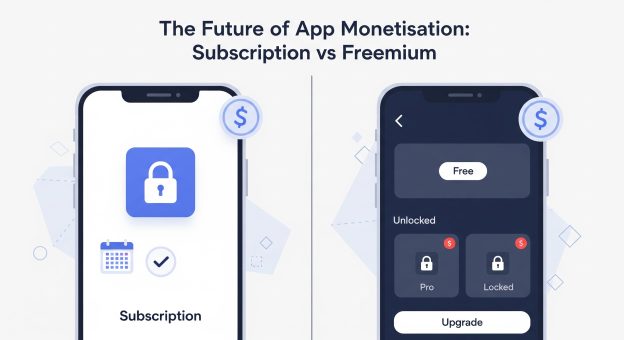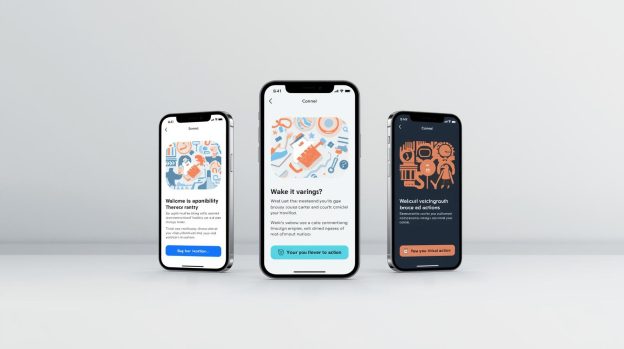The Future of App Monetisation: Subscription vs Freemium

Almost every app you use either works on a subscription model or a freemium model. Subscription-based mobile applications provide access to features and functions after paying the subscription fee. The freemium model is a strategy that businesses are currently embracing to drive more conversions. How do both models differ from one another?
In this blog, we will see the benefits of various app monetisation techniques. To understand which model works better, we need to first know what they entail. So let’s dive in.
How to Choose the Right Monetisation Strategy for Mobile Apps?
Mobile apps are deeply integrated in our everyday lives, be it a simple alarm application, music streaming, house hunting, etc. With the increasing use of mobile devices, there are indispensable applications for entertainment, shopping, work, communication, etc.
Businesses that focus on app monetisation want to convert the app’s value into a sustainable revenue stream by using user engagement, user base and experiences. Hence, businesses need the right monetisation strategy to bring in funds that support long-term business growth, enhance user experience and give an opportunity to further develop the app.
App monetisation cannot be just based on a one-size-fits-all solution. You need to properly strategise and see which monetisation strategy will fit the audience’s preferences, behaviour and willingness to pay.
Among various monetisation strategies, there are in-app advertising, in-app purchases, hybrid monetisation models, subscription models like premium subscription, and freemium subscription.
What are Subscription-based Models?
Premium subscription-based mobile applications require a recurring payment from users on a monthly, quarterly or annual basis. Without paying the subscription fee, users cannot access the features of the app.
Examples of Premium Subscription Apps
Users can enjoy access to the premium content, services and features of the application by paying a subscription fee. Premium subscription model of mobile apps allows users to access services till the time of their subscription. For example, Netflix, the biggest online video streaming platform, uses a premium subscription model. Netflix offers several plans to users based on the number of screens, quality of the video and period of the subscription.
There are productivity tools like Microsoft 365, which use a premium subscription model. Such applications and platforms that use a premium subscription model foster long-term customer relationships and ensure a predictable revenue stream.
What is a Freemium Model?
As opposed to the premium subscription models, freemium applications allow users to access basic functionality and features for free. Freemium applications provide limited features to the users without requiring any upfront payment.
However, the freemium applications secure the ad-free experience, premium content and advanced features of the application behind a pay wall. To truly experience advanced features and functionalities of the application, users will have to upgrade by paying a subscription fee. The freemium subscription model encourages users to upgrade to enjoy more features and functionalities within the app.
Examples of Freemium Subscription Apps
Popular examples using a freemium model include Canva, Spotify and mobile games like Candy Crush.
There are several gamification features in the Candy Crush mobile game. Gamification features keep users glued to the game while the freemium model allows users to make in-app purchases. Users can buy new elements and features while playing the game. Similarly, Spotify is one of the largest music streaming platforms where users can enjoy music without paying a subscription fee. However, to enjoy an ad-free experience on Spotify, users will need to upgrade their plan.
Spotify allows users to listen to music for free without requiring any payment upfront, but it embeds advertisements in the application that hamper users’ experience. However, freemium apps are different from premium subscription apps as they attract a large user base. Freemium apps initially remove the barrier to entry and then encourage users to shift to a paid model to enjoy more features.
Let’s Explore The Difference Between Freemium and Premium Subscription Model
| Features/Functionalities | Freemium Subscription App | Premium Subscription App |
| Revenue Model | Generate Income using in-app purchases, ads or premium upgrade | Rely on recurring monthly, quarterly or yearly subscription fee |
| User Experience | Includes ads and limited features in the free model | Ad-free experience for users and access to premium and advanced features |
| Accessibility | Free access to basic features and functionalities, inclusive of ads | Paid and ad-free access to all features and functionalities within the app |
| User Retention | More focus on user acquisition and conversion | Focus on long-term engagement of users |
To Sum Up
The premium and freemium models are both popular monetisation strategies for mobile applications. On one hand, the freemium model allows users to access basic functions and pay for the premium features. The premium subscription-based model allows users to access all advanced features by paying a subscription fee first.
Freemium applications can reach a broad audience by scaling quickly, requiring only minimal marketing costs. As opposed to this, the premium subscription models enable long-term relationships with customers. The financial uncertainty in premium subscription apps is not an issue as they provide a predictable revenue stream. The future of app monetisation depends broadly on these two strategies.
If your business requires a full-fledged and functional mobile application, you can contact our developers at VerveLogic, a leading mobile application development company in USA. Our developers can assist you in monetising the application by employing a subscription model, depending on the user preferences and behaviours.




